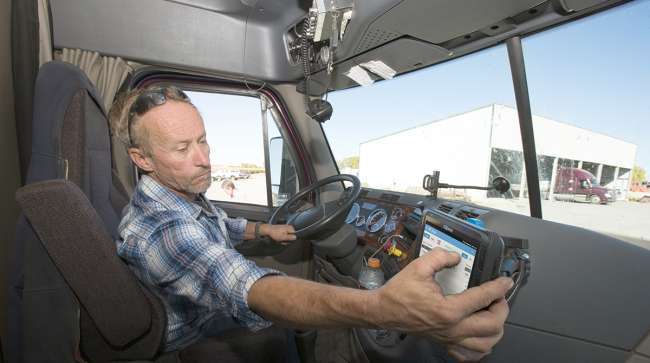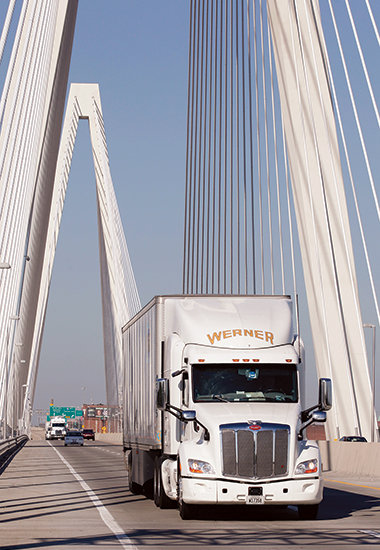Dawn of the ELD Era

The arrival of the electronic logging device mandate later this year is widely expected to create significant ripple effects across the supply chain.
The move to ELDs will change the competitive landscape in the trucking industry by leveling the playing field for compliance with driver hours-of-service limits, carriers said.
YOUR GUIDE TO THE MANDATE: Downloadable PDF.
At the same time, fleet executives and analysts generally expect the mandate to remove some amount of freight hauling capacity from the industry. The data collected by the devices, however, ultimately could make carriers more efficient through improved planning.
Meanwhile, some shippers already are taking steps to partner with proven, compliant carriers before the ELD implementation deadline.
The Federal Motor Carrier Safety Administration’s electronic logging rule will require nearly all interstate carriers to use ELDs instead of paper logbooks to record drivers’ hours beginning Dec. 18. Carriers using existing e-log devices that meet current specifications — known as automatic onboard recording devices, or AOBRDs — will be able to continue using them for two more years.
While electronic logs will be new for much of the trucking industry, some fleets have been using them for many years.

Truckload carrier Werner Enterprises has been using electronic logs for 20 years. (John Sommers II for Transport Topics)
Werner Enterprises Inc. converted to e-logs 20 years ago. The truckload carrier experienced a 4.5% productivity loss during the first year with e-logs, but was “back to neutral” around year three and “really [has] seen it as a positive since then,” Werner CEO Derek Leathers said during an interview for Transport Topics’ LiveOnWeb program.
Leathers said he expects the industry’s total freight hauling capacity to contract by 2.5% to 5% when the mandate goes into effect.
“When you take miles out, it is the same as taking trucks out,” he said, but he added that the industrywide conversion to ELDs is the right thing to do. “We need to be on a level playing field.”
Dedicated fleets may experience a greater loss of productivity, Leathers said. “Dedicated fleets have more touching of freight, more stopping and starting, more stops along the route, etc., and electronic logs will have a greater impact there,” he said.
Werner, based in Omaha, Neb., ranks No. 16 on the Transport Topics Top 100 list of the largest for-hire carriers in North America.
Leathers also said shippers are working to align themselves with quality, compliant carriers in advance of the mandate.
“Clearly, customer and shipper behavior seems to be taking it seriously as it relates to market share shifts to carriers that are fully compliant and have a long track record,” he said.
As business shifts toward carriers that are prepared for the mandate, it is likely that some shippers could struggle to find enough trucks to move their freight.
“Shippers who haven’t seen the wisdom in developing true partnerships with their carrier base are likely going to find it harder to get the needed trucks,” said Dave Osiecki, CEO of Scopelitis Transportation Consulting.
Osiecki predicted that the industry will see a 3% to 6% decrease in hauling capacity.
“It may sound small, but every percentage point of capacity reduction is significant,” he said.
Even modest changes in supply can affect pricing, said Brad Delco, transportation analyst at Stephens Inc., a financial services firm based in Little Rock, Ark.
“It could be extremely painful for the entire supply chain,” he said.
The only way to offset the capacity loss is to place more trucks on the road, but finding drivers for the trucks is a problem, Delco said. “We’ve been in a driver shortage situation for a long time.”

Steve Beckham, a driver with AllSource Logistics. The fleet is making the transition to e-logs ahead of the ELD mandate. (AllSource Logistics)
James Smith, safety coordinator for AllSource Logistics, also expects to see a significant decrease in hauling capacity with ELDs.
“I don’t think that we’ll be able to get back to the same capacity we’re running at now,” he said.
AllSource Logistics, a small carrier based in Lawrenceburg, Tenn., is transitioning its fleet of 16 trucks to ELDs.
Despite the challenges, Smith said he believes ELDs will make the fleet safer in the long run.
Midwest Freight Systems Corp., a carrier based in Warren, Mich., also is in the process of implementing ELDs.
“The faster we can figure out how to run our lanes on e-logs and how to make everything work, the least amount of losses we’re going to have,” said Edin Selimagic, the fleet’s safety manager.
About 40% of Midwest Freight’s drivers already are showing some type of activity on the devices, he said. “They are practicing and at least trying to understand the system.”
But the learning process extends beyond the drivers. Midwest Freight also is working to educate its dispatchers.
“They’re going to have to get training and understand when to leave a driver alone and when to put him on the road,” Selimagic said. “They’ll have to get better with logistics planning.”
C.R. England Inc., which experienced a 3% to 5% productivity decline when it moved to e-logs in 2009, helped minimize that loss by leveraging visibility, optimizing load planning and maximizing drivers’ hours of service.
“That helped us to offset what could have been a much larger productivity loss,” said Brandon Harrison, chief sales officer for the Salt Lake City-based carrier, which ranks No. 26 on the for-hire TT100.
Nevertheless, tightened capacity could lead to service disruptions, Harrison said.
C.R. England tripled its number of necessary relays due to hours-of-service issues after implementing e-logs. If drivers get stuck in traffic, for example, they may run out of hours before making a delivery.
“You’re going to run the risk of not meeting a scheduled appointment time, and carriers are going to have to be very diligent about rebounding to make sure that doesn’t create a service failure,” he said.
C.R. England also increased the number of spot trailers it uses with some customers.
“There is no doubt more and more shippers will be requiring spot trailers,” Harrison said. “There is a productivity benefit, but it comes at a cost, especially for refrigerated providers, and that will affect rate.”
C.R. England experienced a significant disadvantage on pricing when it transitioned to e-logs, Harrison said. When the mandate goes into effect, however, it will help the company be more price competitive because of the level playing field, especially for regional loads with a shorter length of haul.
Averitt Express has been using e-logs in its truckload operations for five years and expects to begin using the electronic hours-of-service feature on its Omnitracs systems across its entire less-than-truckload fleet in October.
Amos Rogan, LTL operations productivity and efficiency leader for the Cookeville, Tenn.-based carrier, doesn’t expect to see a productivity loss from a driver standpoint, but he knows there will be additional administrative tasks for leadership and administrative support employees.
Averitt ranks No. 31 on the for-hire TT100.
The ELD mandate’s effect on freight capacity will depend in large part on how strictly the rule is enforced.
There will be no grace period for ELD implementation, said Bill Reese, director of the cooperative hazardous materials enforcement development program for the Commercial Vehicle Safety Alliance.
“Carriers have been aware of the ELD mandate since the final rule was passed on Feb. 16, 2016. They’ve had almost two years to prepare,” he said.
Inspectors will enforce the ELD mandate in much the same way that they currently enforce the requirement to maintain records-of-duty status during roadside inspections.
Drivers without compliant ELDs in their trucks will be placed out of service for 10 hours. If drivers choose to continue operating without an ELD after that 10-hour period, they are subject to being put out of service for another 10 hours each time they are stopped again, Reese said.
Even if law enforcement doesn’t closely monitor ELD compliance, insurance carriers might.
“If you’re going to insure them and you know this data is available, you want to see that,” said Delco, of Stephens Inc.
Financial underwriters also may want to verify that carriers are ELD compliant, said David Roush, president of KSM Transport Advisors.
“Somebody who is lending them money should want to know if there is a risk of that carrier being sanctioned,” Roush said.
As carriers chart out their strategies for ELD implementation, they will be able to choose from an increasingly wide array of products, ranging from advanced fleet management systems to simpler, less expensive devices focused primarily on meeting the basic requirements of the regulation.
Carriers that select ELD systems with functionality beyond HOS compliance will have more data to analyze and use, which could lead to greater efficiency.
“Companies that choose compliance-only ELDs are not likely to see the same safety and efficiency gains,” Scopelitis’ Osiecki said.
Many e-log systems include applications designed to help fleets change unwanted driver behavior such as hard braking, excessive idling and speeding. They also can provide information to improve negotiations with shippers on issues such as rates and driver detention time.
“It is an opportunity if carriers choose to take it,” Osiecki said.

In addition to e-logs, Old Dominion Freight Line uses its onboard systems to track vehicle and driver performance. (John Sommers II for Transport Topics)
Old Dominion Freight Line, which moved to e-logs in 2010, uses its systems to improve miles per gallon by tracking vehicle usage and actual mileage expense, said Sam Faucette, vice president of safety and compliance.
“Actual mpg improvements were accomplished by educating drivers on the results of how they operated the equipment,” he said.
The e-log system also provides a transparent record of a driver’s movements during the work shift, which created opportunities for improvements in driver scheduling, driver performance and overall safety, Faucette said.
“While HOS rules are designed to regulate the amount of work a driver performs, they cannot require that a driver get the necessary rest when off duty. Exception-based reporting provides the opportunity to counsel and retrain a driver when certain indicators are apparent,” he said. “Safety improvements can be a positive for the entire enterprise, from reduced liability costs, reducing driver and equipment downtime and improving public safety.”
ODFL, based in Thomasville, N.C., ranks No. 11 on the for-hire TT100.
Smith, of AllSource Logistics, hopes ELDs will make drivers more efficient and make it easier to track miles traveled in each state for tax purposes.
“That can be difficult to keep up with,” he said. “We rely on drivers right now to write down when they cross a state line.”
Midwest Freight also is implementing ELDs with fleet-management capabilities, as well as dash cameras to monitor performance, Selimagic said.
“We’re going to be using all of the features they have to better utilize our trucks and our fuel,” he said.
Selimagic also anticipates that shippers and receivers will start setting loading times.
Driver detention time at a shipper or receiver’s facility is a common source of hours-of-service problems, he said. “Once that 14-hour clock starts, it doesn’t stop.”
KSM’s Roush said carriers can use the data gathered by their ELD systems to find more time.
“The real benefit comes from … the ability to mine the data and use it to understand how to get more productivity out of drivers,” he said. “By having a better handle on the time, you’re able to make better decisions.”
Roush said better information could change conversations with shippers as well.
“Instead of just saying, ‘You’re holding drivers up,’ now you have data that is a legal document, and you can go in and drive change,” he said.
That has been the case at C.R. England. Harrison said e-logs have influenced the carrier’s discussions with customers, particularly regarding detention time and rates.
“There were a lot of conversations that took place specific to loading and unloading procedures,” Harrison said.


